Enhanced Dynamic Impact Resistance of 3D-Printed Continuous Optical Fiber-Reinforced Helicoidal Polylactic Acid Composites
Abstract
:1. Introduction
2. Materials and Methods
2.1. Fabrication of Material and Specimens
2.2. High-Strain-Rate Impact Testing
2.3. Finite Element Modeling
3. Results and Discussions
3.1. Material Mechanical Testing
3.2. Porosity Analysis
3.3. Validation
3.4. Impact Resistance Behavior
3.5. Strain Rate Effect
3.6. Impact Energy Curves
3.7. Dynamic Impact Deformation of Specimens
3.8. Computational Results
4. Conclusions
Author Contributions
Funding
Institutional Review Board Statement
Data Availability Statement
Conflicts of Interest
References
- Sadeghi, H.; Davey, K.; Darvizeh, R.; Darvizeh, A. A scaled framework for strain rate sensitive structures subjected to high rate impact loading. Int. J. Impact Eng. 2019, 125, 229–245. [Google Scholar] [CrossRef]
- Walter, T.; Subhash, G.; Sankar, B.; Yen, C. Damage modes in 3D glass fiber epoxy woven composites under high rate of impact loading. Compos. Part B Eng. 2009, 40, 584–589. [Google Scholar] [CrossRef]
- Yamamoto, N.; de Villoria, R.G.; Wardle, B.L. Electrical and thermal property enhancement of fiber-reinforced polymer laminate composites through controlled implementation of multi-walled carbon nanotubes. Compos. Sci. Technol. 2012, 72, 2009–2015. [Google Scholar] [CrossRef]
- Bian, Y.; Chai, H.; Ye, S.; Xie, H.; Yao, X.; Cai, Y. Compression and spallation properties of polyethylene terephthalate under plate impact loading. Int. J. Mech. Sci. 2021, 211, 106736. [Google Scholar] [CrossRef]
- Reddy, T.S.; Reddy, P.R.S.; Madhu, V. Response of E-glass/epoxy and Dyneema® composite laminates subjected to low and high velocity impact. Procedia Eng. 2017, 173, 278–285. [Google Scholar] [CrossRef]
- Zhou, J.; Liu, J.; Zhang, X.; Yan, Y.; Jiang, L.; Mohagheghian, I.; Dear, J.; Charalambides, M. Experimental and numerical investigation of high velocity soft impact loading on aircraft materials. Aerosp. Sci. Technol. 2019, 90, 44–58. [Google Scholar] [CrossRef]
- Rivera, J.; Yaraghi, N.A.; Huang, W.; Gray, D.; Kisailus, D. Modulation of impact energy dissipation in biomimetic helicoidal composites. J. Mater. Res. Technol. 2020, 9, 14619–14629. [Google Scholar] [CrossRef]
- Wang, J.; Li, N.; Fu, K.; Li, Y.; Yang, B. Nature-Mimic Tough Helicoidal Composites with Aligned Short Carbon Fibers by 3D Printing. Macromol. Mater. Eng. 2022, 307, 2100680. [Google Scholar] [CrossRef]
- Yin, S.; Guo, W.; Wang, H.; Huang, Y.; Yang, R.; Hu, Z.; Chen, D.; Xu, J.; Ritchie, R.O. Strong and tough bioinspired additive-manufactured dual-phase mechanical metamaterial composites. J. Mech. Phys. Solids 2021, 149, 104341. [Google Scholar] [CrossRef]
- Yin, S.; Yang, R.; Huang, Y.; Guo, W.; Chen, D.; Zhang, W.; Ren, M.; Zhou, Y.; Xu, J. Toughening mechanism of coelacanth-fish-inspired double-helicoidal composites. Compos. Sci. Technol. 2021, 205, 108650. [Google Scholar] [CrossRef]
- Zimmermann, E.A.; Gludovatz, B.; Schaible, E.; Dave, N.K.; Yang, W.; Meyers, M.A.; Ritchie, R.O. Mechanical adaptability of the Bouligand-type structure in natural dermal armour. Nat. Commun. 2013, 4, 2634. [Google Scholar] [CrossRef] [PubMed]
- Zaheri, A.; Fenner, J.S.; Russell, B.P.; Restrepo, D.; Daly, M.; Wang, D.; Hayashi, C.; Meyers, M.A.; Zavattieri, P.D.; Espinosa, H.D. Revealing the mechanics of helicoidal composites through additive manufacturing and beetle developmental stage analysis. Adv. Funct. Mater. 2018, 28, 1803073. [Google Scholar] [CrossRef]
- Yang, R.; Zaheri, A.; Gao, W.; Hayashi, C.; Espinosa, H.D. AFM identification of beetle exocuticle: Bouligand structure and nanofiber anisotropic elastic properties. Adv. Funct. Mater. 2017, 27, 1603993. [Google Scholar] [CrossRef]
- Amorim, L.; Santos, A.; Nunes, J.; Dias, G.; Viana, J. Quasi static mechanical study of vacuum bag infused bouligand inspired composites. Polym. Test. 2021, 100, 107261. [Google Scholar] [CrossRef]
- Liu, Y.; Shen, J.; Li, Y.; Ge, X.; Li, Y. Enhanced high-strain-rate impact resistance of helicoidal composites by fused deposition modelling. Mech. Adv. Mater. Struct. 2022, 29, 7796–7808. [Google Scholar] [CrossRef]
- Faruk, O.; Bledzki, A.K.; Fink, H.-P.; Sain, M. Biocomposites reinforced with natural fibers: 2000–2010. Prog. Polym. Sci. 2012, 37, 1552–1596. [Google Scholar] [CrossRef]
- Le Duigou, A.; Davies, P.; Baley, C. Environmental impact analysis of the production of flax fibres to be used as composite material reinforcement. J. Biobased Mater. Bioenergy 2011, 5, 153–165. [Google Scholar] [CrossRef]
- Satyanarayana, K.G.; Arizaga, G.G.; Wypych, F. Biodegradable composites based on lignocellulosic fibers—An overview. Prog. Polym. Sci. 2009, 34, 982–1021. [Google Scholar] [CrossRef]
- Eshkoor, R.; Ude, A.; Oshkovr, S.; Sulong, A.; Zulkifli, R.; Ariffin, A.; Azhari, C. Failure mechanism of woven natural silk/epoxy rectangular composite tubes under axial quasi-static crushing test using trigger mechanism. Int. J. Impact Eng. 2014, 64, 53–61. [Google Scholar] [CrossRef]
- Rezghi Maleki, H.; Hamedi, M.; Kubouchi, M.; Arao, Y. Experimental investigation on drilling of natural flax fiber-reinforced composites. Mater. Manuf. Process. 2019, 34, 283–292. [Google Scholar] [CrossRef]
- Zhu, Y.; Liu, J.; Liu, D.; Xu, H.; Yan, C.; Huang, B.; Hui, D. Fiber path optimization based on a family of curves in composite laminate with a center hole. Compos. Part B Eng. 2017, 111, 91–102. [Google Scholar] [CrossRef]
- Van Campen, J.M.; Kassapoglou, C.; Gürdal, Z. Generating realistic laminate fiber angle distributions for optimal variable stiffness laminates. Compos. Part B Eng. 2012, 43, 354–360. [Google Scholar] [CrossRef]
- Liu, J.L.; Mencattelli, L.; Zhi, J.; Chua, P.Y.; Tay, T.-E.; Tan, V.B.C. Lightweight, Fiber-Damage-Resistant, and Healable Bio-Inspired Glass-Fiber Reinforced Polymer Laminate. Polymers 2022, 14, 475. [Google Scholar] [CrossRef]
- Zaretsky, E.; DeBotton, G.; Perl, M. The response of a glass fibers reinforced epoxy composite to an impact loading. Int. J. Solids Struct. 2004, 41, 569–584. [Google Scholar] [CrossRef]
- Ashrafi, B.; Guan, J.; Mirjalili, V.; Zhang, Y.; Chun, L.; Hubert, P.; Simard, B.; Kingston, C.T.; Bourne, O.; Johnston, A. Enhancement of mechanical performance of epoxy/carbon fiber laminate composites using single-walled carbon nanotubes. Compos. Sci. Technol. 2011, 71, 1569–1578. [Google Scholar] [CrossRef]
- Deniz, M.E.; Ozen, M.; Ozdemir, O.; Karakuzu, R.; Icten, B.M. Environmental effect on fatigue life of glass–epoxy composite pipes subjected to impact loading. Compos. Part B Eng. 2013, 44, 304–312. [Google Scholar] [CrossRef]
- Unterweger, C.; Duchoslav, J.; Stifter, D.; Fürst, C. Characterization of carbon fiber surfaces and their impact on the mechanical properties of short carbon fiber reinforced polypropylene composites. Compos. Sci. Technol. 2015, 108, 41–47. [Google Scholar] [CrossRef]
- Goh, G.D.; Dikshit, V.; Nagalingam, A.P.; Goh, G.L.; Agarwala, S.; Sing, S.L.; Wei, J.; Yeong, W.Y. Characterization of mechanical properties and fracture mode of additively manufactured carbon fiber and glass fiber reinforced thermoplastics. Mater. Des. 2018, 137, 79–89. [Google Scholar] [CrossRef]
- Huang, Y.; Meng, X.; Xie, Y.; Lv, Z.; Wan, L.; Cao, J.; Feng, J. Friction spot welding of carbon fiber-reinforced polyetherimide laminate. Compos. Struct. 2018, 189, 627–634. [Google Scholar] [CrossRef]
- Hu, J.; Yin, S.; Yu, T.; Xu, J. Dynamic compressive behavior of woven flax-epoxy-laminated composites. Int. J. Impact Eng. 2018, 117, 63–74. [Google Scholar] [CrossRef]
- Kousiatza, C.; Tzetzis, D.; Karalekas, D. In-situ characterization of 3D printed continuous fiber reinforced composites: A methodological study using fiber Bragg grating sensors. Compos. Sci. Technol. 2019, 174, 134–141. [Google Scholar] [CrossRef]
- Ouyang, J.; Chen, X.; Huangfu, Z.; Lu, C.; Huang, D.; Li, Y. Application of distributed temperature sensing for cracking control of mass concrete. Constr. Build. Mater. 2019, 197, 778–791. [Google Scholar] [CrossRef]
- Yan, R.; Wang, Y.; Luo, P.; Li, Y.; Lu, X. Fused filament fabrication of continuous optic fiber reinforced polylactic acid composites. Rapid Prototyp. J. 2022, 28, 766–776. [Google Scholar] [CrossRef]
- Li, N.; Link, G.; Jelonnek, J. 3D microwave printing temperature control of continuous carbon fiber reinforced composites. Compos. Sci. Technol. 2020, 187, 107939. [Google Scholar] [CrossRef]
- Sarvestani, H.Y.; Akbarzadeh, A.; Niknam, H.; Hermenean, K. 3D printed architected polymeric sandwich panels: Energy absorption and structural performance. Compos. Struct. 2018, 200, 886–909. [Google Scholar] [CrossRef]
- Lei, M.; Hamel, C.M.; Yuan, C.; Lu, H.; Qi, H.J. 3D printed two-dimensional periodic structures with tailored in-plane dynamic responses and fracture behaviors. Compos. Sci. Technol. 2018, 159, 189–198. [Google Scholar] [CrossRef]
- Yin, S.; Chen, H.; Yang, R.; He, Q.; Chen, D.; Ye, L.; Mai, Y.-W.; Xu, J.; Ritchie, R.O. Tough nature-inspired helicoidal composites with printing-induced voids. Cell Rep. Phys. Sci. 2020, 1, 141–167. [Google Scholar] [CrossRef]
- Sharma, A.; Mishra, R.; Jain, S.; Padhee, S.S.; Agnihotri, P.K. Deformation behavior of single and multi-layered materials under impact loading. Thin-Walled Struct. 2018, 126, 193–204. [Google Scholar] [CrossRef]
- Gray III, G.; Blumenthal, W.R. Split-Hopkinson pressure bar testing of soft materials. ASM Handb. 2000, 8, 488–496. [Google Scholar]
- Kolsky, H. An investigation of the mechanical properties of materials at very high rates of loading. Proc. Phys. Soc. Sect. B 1949, 62, 676. [Google Scholar] [CrossRef]
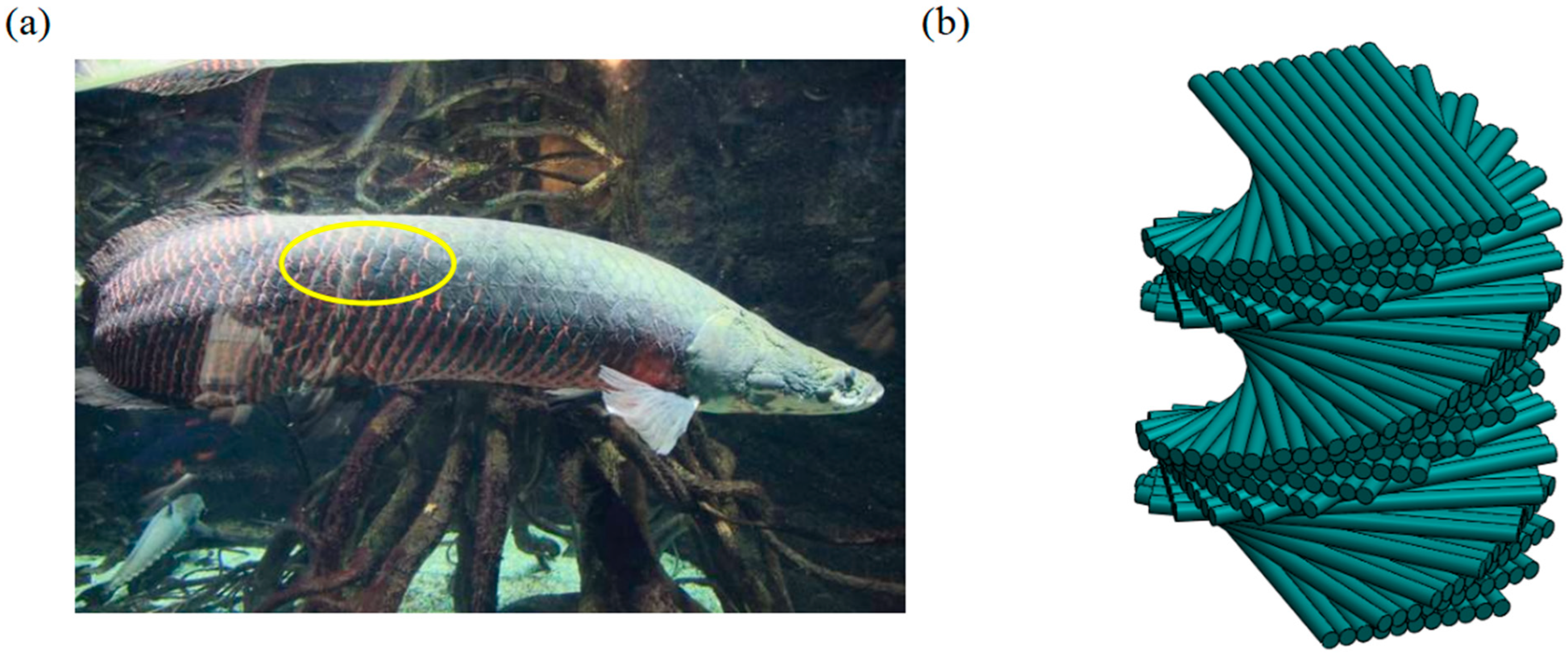
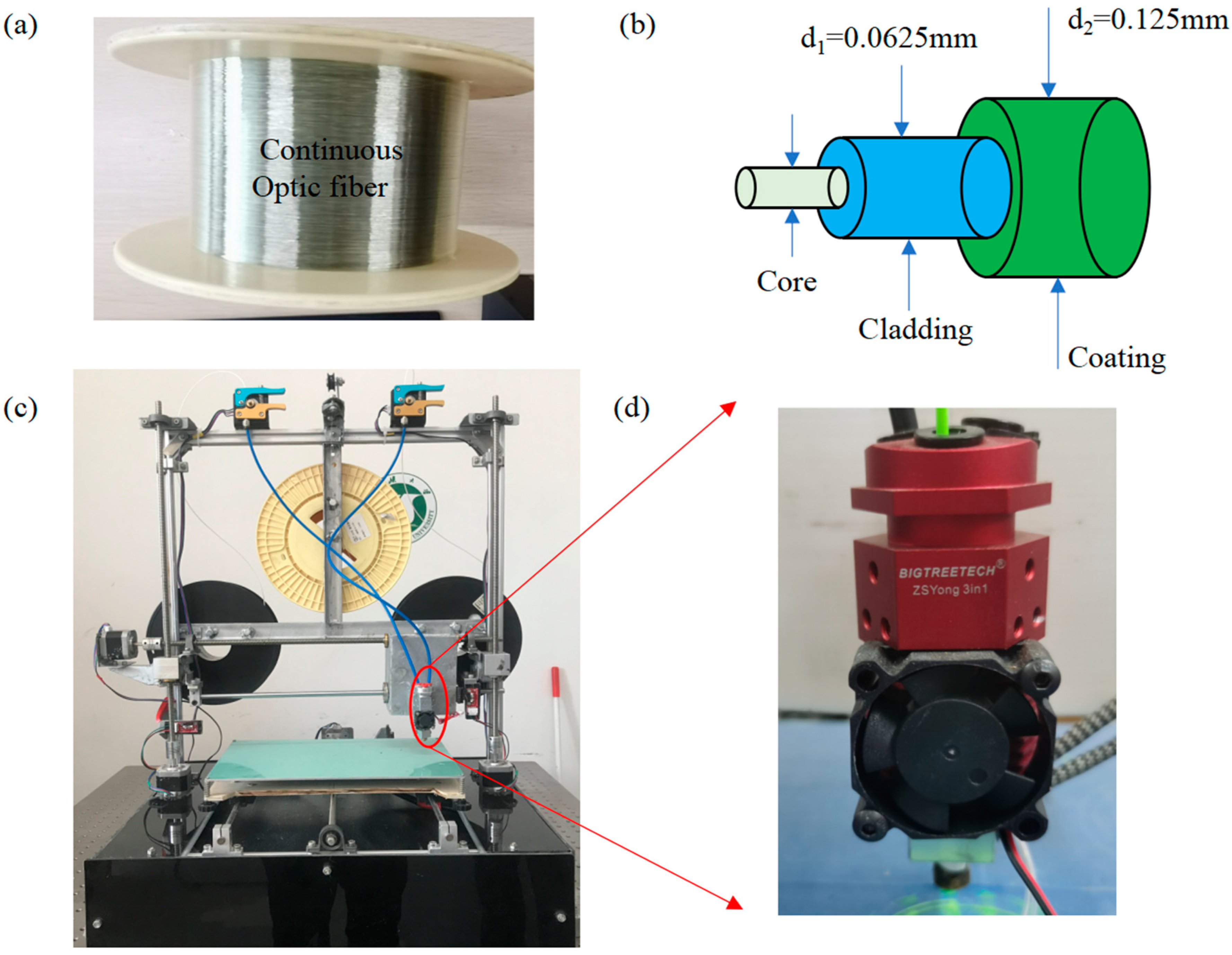
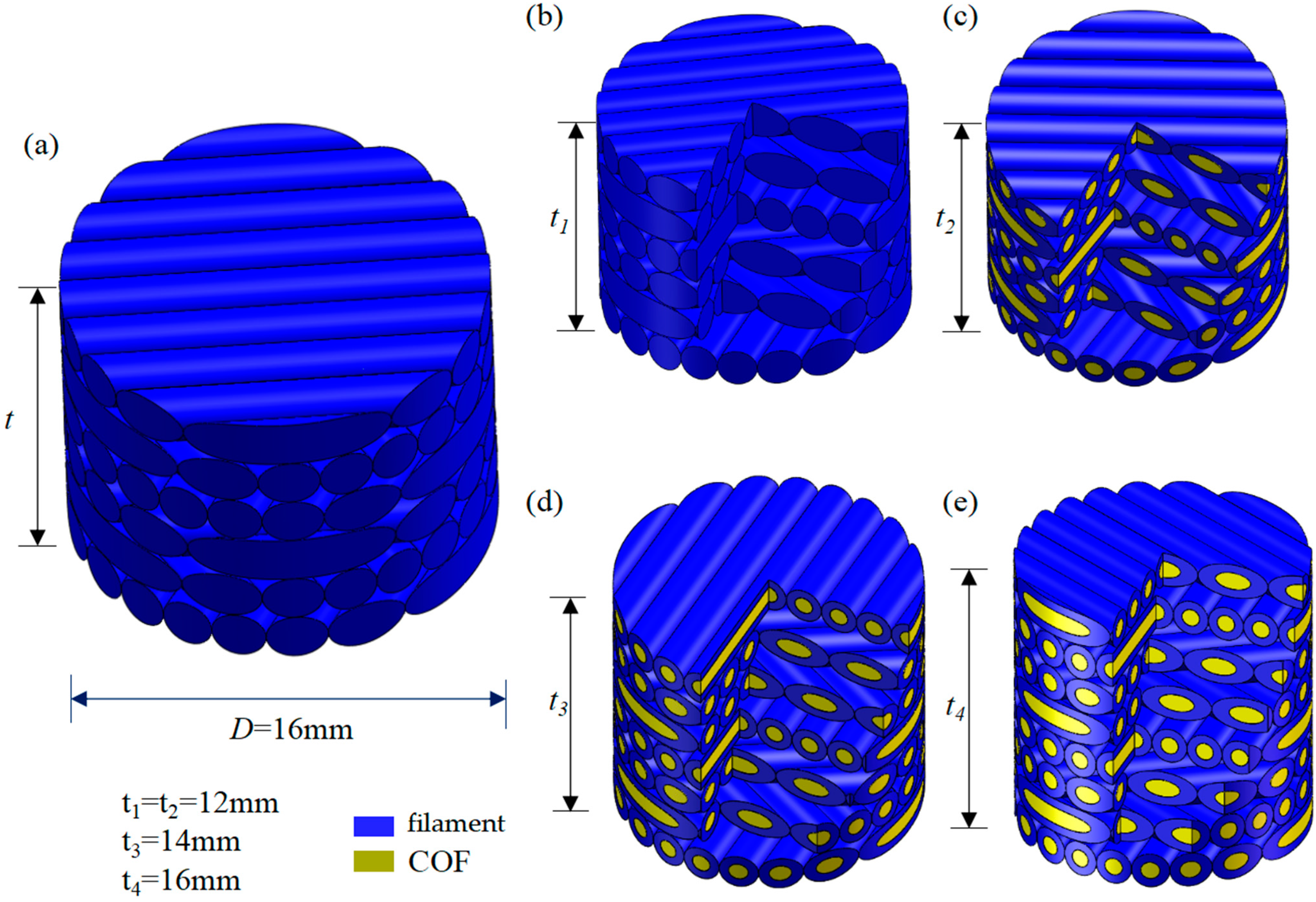

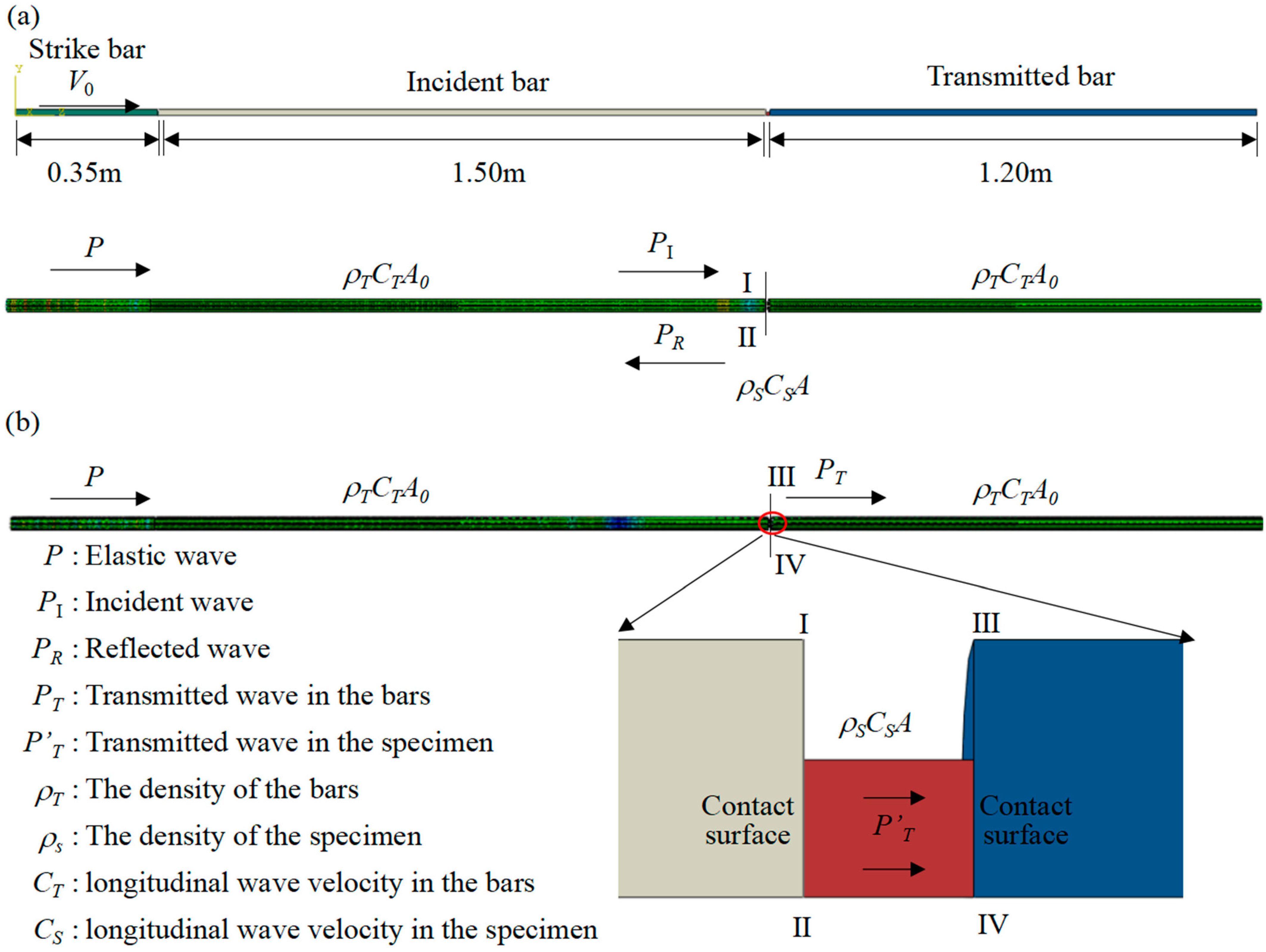
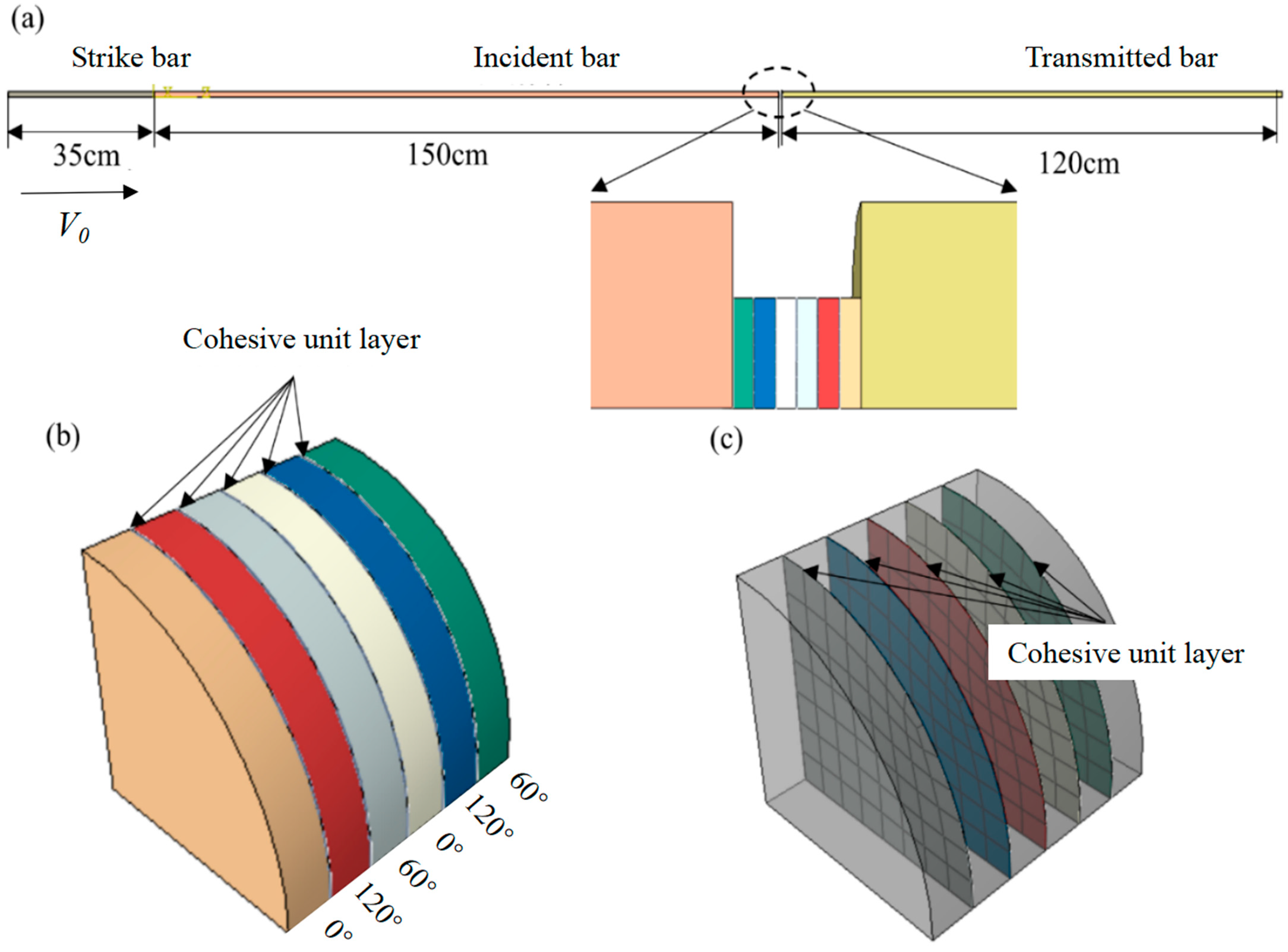


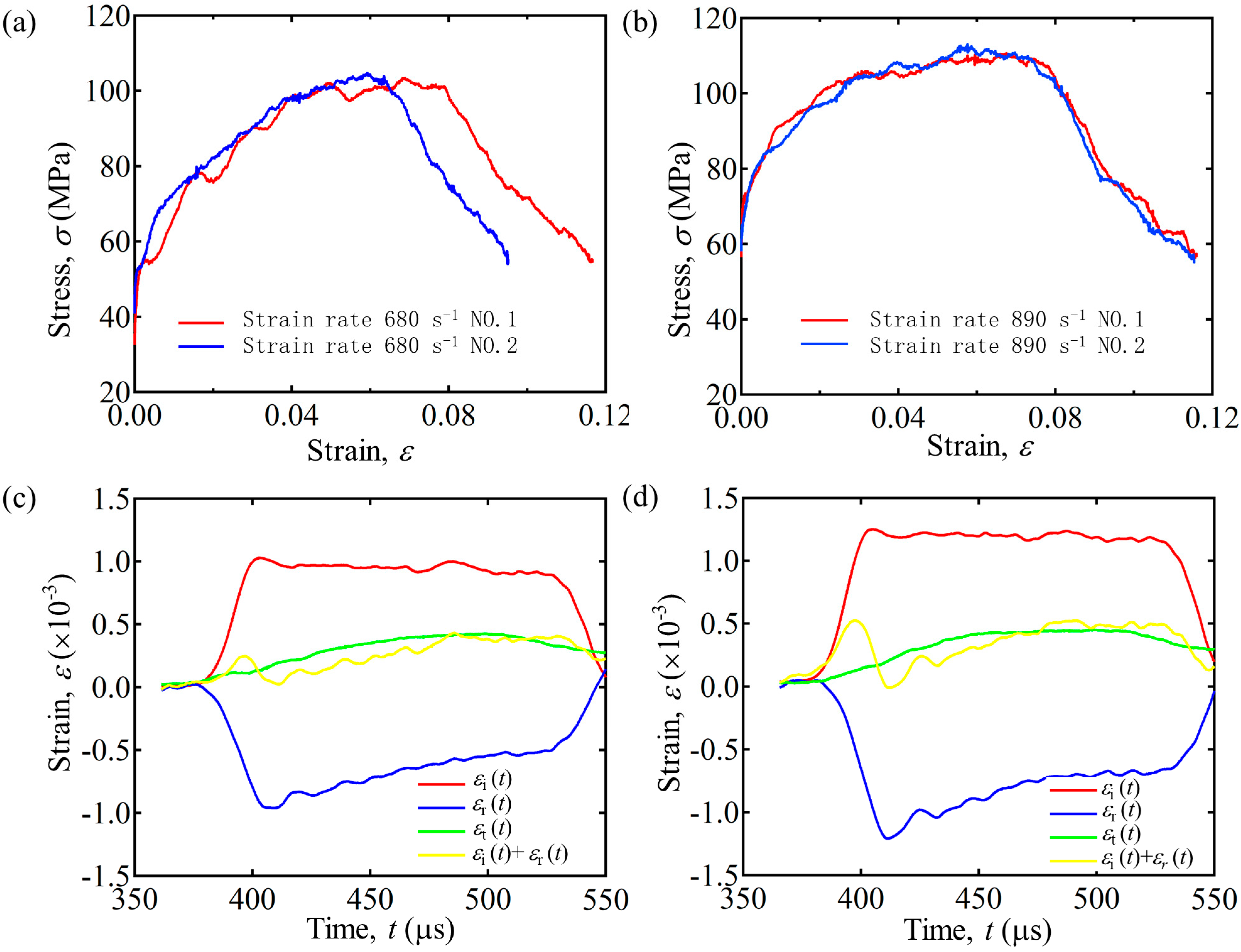
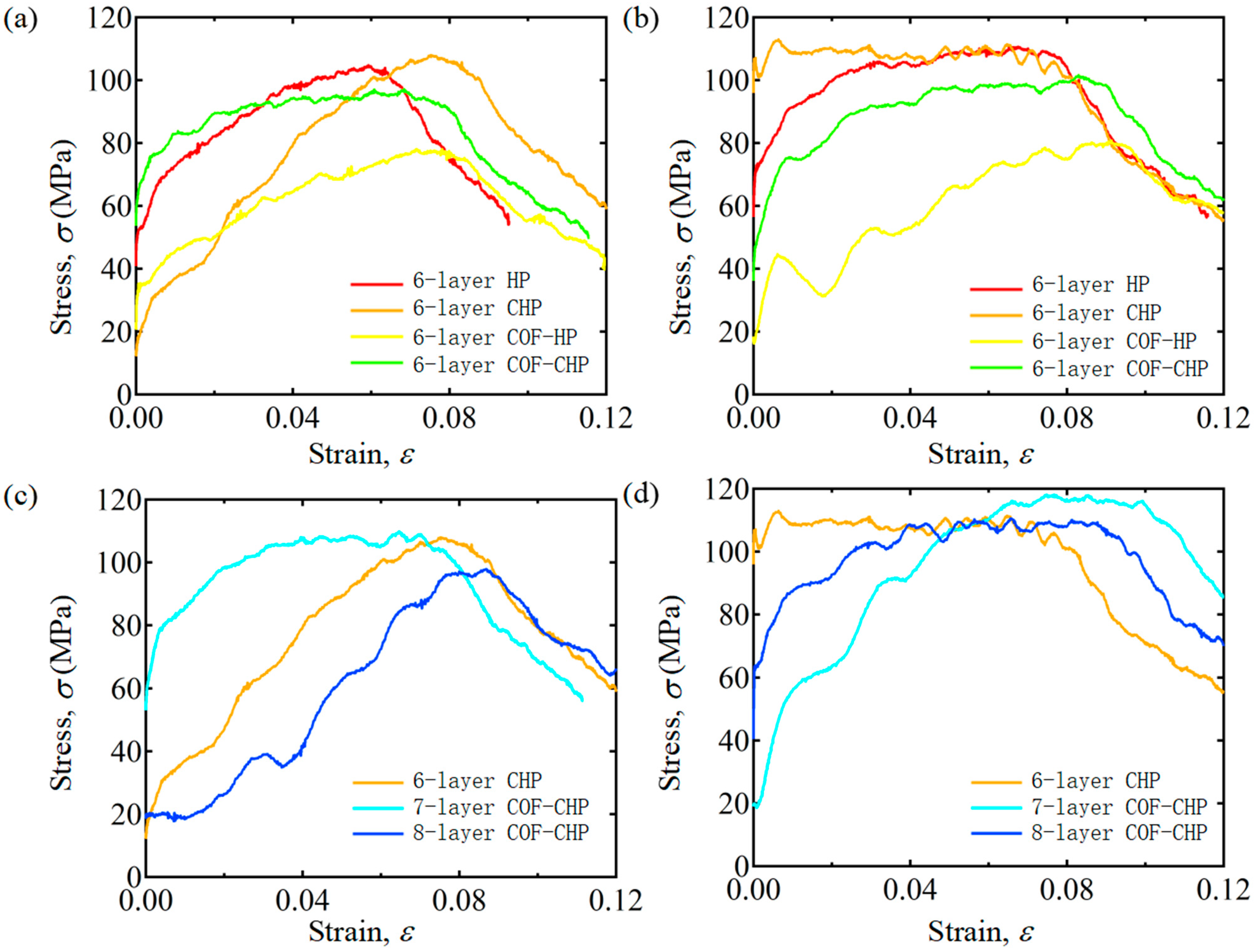
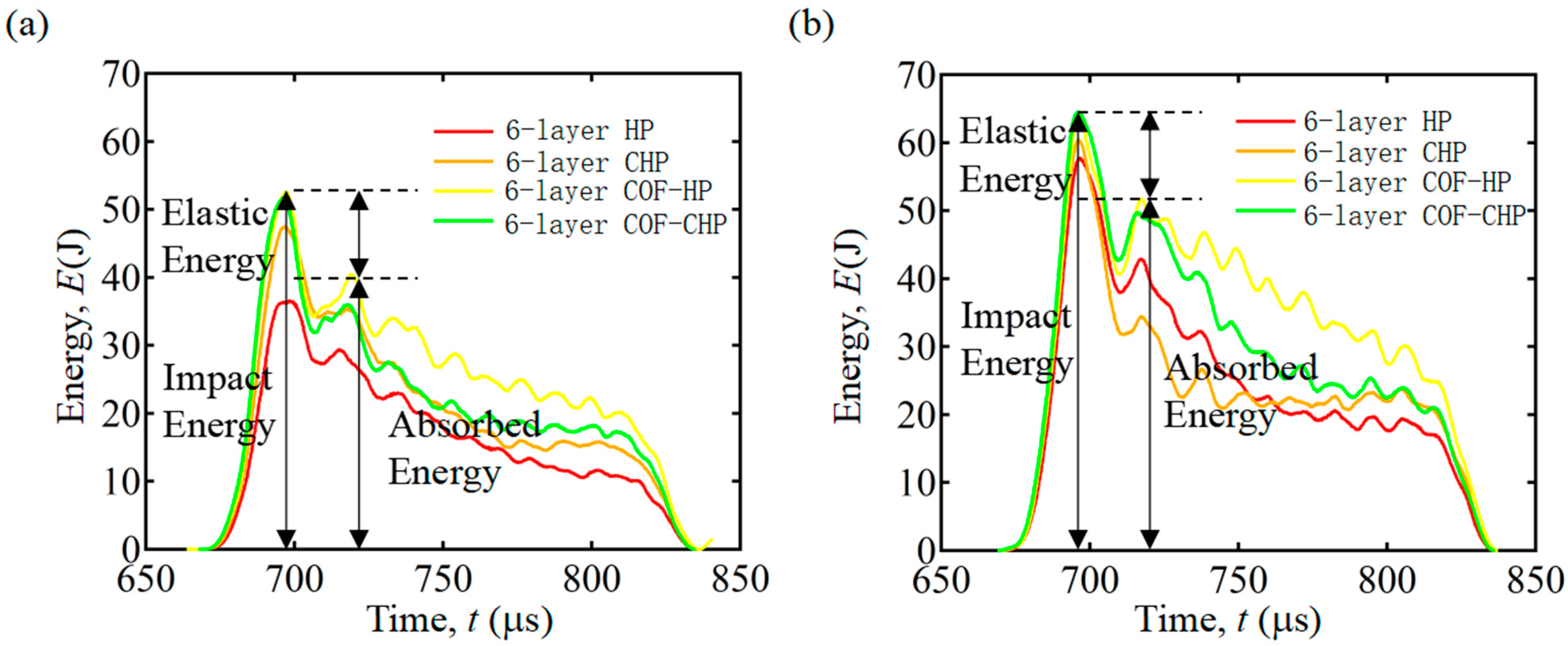


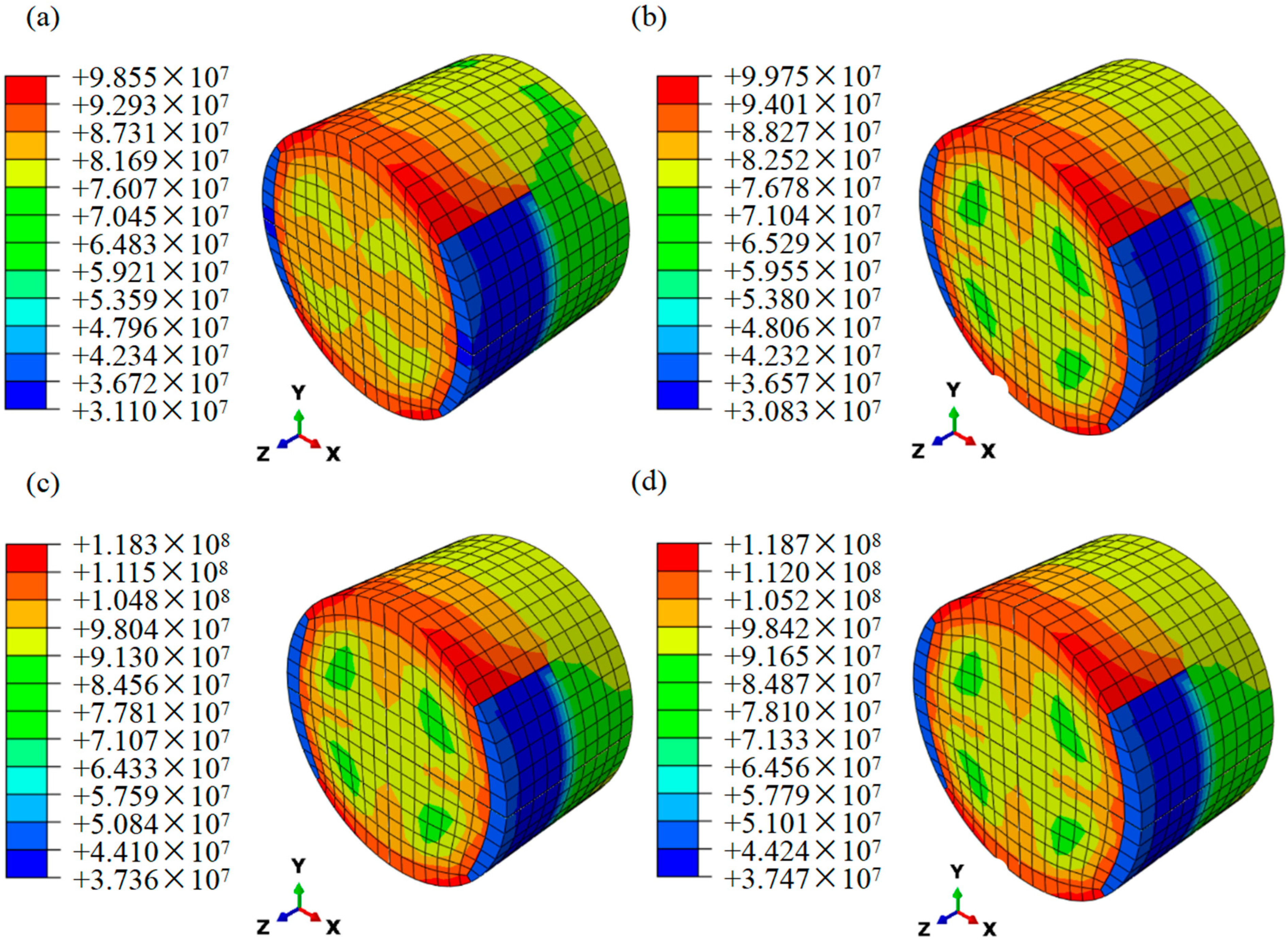
| Dimensions | Printing Parameters | Density ρ (kg/m3) | COF Doping (Y/N) | |||
|---|---|---|---|---|---|---|
| D (mm) | t (mm) | Layer T (mm) | Nozzle d (mm) | |||
| 6-layer HP | 16 | 12 | 0.4 | 1.4 | 1220 | N |
| 6-layer CHP | 16 | 10 | 0.4 | 1.4 | 1464 | N |
| 6-layer COF-HP | 16 | 12 | 0.4 | 1.4 | 1230 | Y |
| 7-layer COF-HP | 16 | 14 | 0.4 | 1.4 | 1230 | Y |
| 8-layer COF-HP | 16 | 16 | 0.4 | 1.4 | 1230 | Y |
| 6-layer COF-CHP | 16 | 10 | 0.4 | 1.4 | 1476 | Y |
| 7-layer COF-CHP | 16 | 10 | 0.4 | 1.4 | 1722 | Y |
| 8-layer COF-CHP | 16 | 10 | 0.4 | 1.4 | 1968 | Y |
| Elastic Constants | Value (COF-HP/HP) | Elastic Constants | Value (COF-HP/HP) |
|---|---|---|---|
| Modulus in fiber direction E1 = E2 (GPa) | 0.99/0.8 | Longitudinal tensile strength Xt (MPa) | 62.26/60.70 |
| Transverse moduli E3 (GPa) | 0.81/1.1 | Longitudinal compressive strength Xc (MPa) | 80/74 |
| Shear moduli G12 (GPa) | 0.35/0.3 | Transverse tensile strength Yt (MPa) | 44.33/60.08 |
| Shear moduli G13 = G23 (GPa) | 0.31/0.44 | Transverse compressive strength Yc (MPa) | 60/69 |
| Poisson’s ratio v12 | 0.4/0.3 | Shear strength S12 (MPa) | 23/12 |
| Poissons’ ratio v13 = v23 | 0.3/0.24 | Shear strength S13 = S23 (MPa) | 31.07/21 |
| Density ρ (kg/m3) | 1230/1220 |
| Stress σmax (MPa) | Strain ε | |
|---|---|---|
| COF-filament | 62.26 | 0.123 |
| PLA-filament | 60.7 | 0.148 |
| COF-contact | 44.32 | 0.110 |
| PLA-contact | 57.48 | 0.118 |
| Etan (GPa) | σmax (MPa) | ε | |
|---|---|---|---|
| 6-layer HP | 1.08 | 104.84 | 0.059 |
| 6-layer CHP | 0.88 | 109.92 | 0.065 |
| 6-layer COF-HP | 0.79 | 78.07 | 0.072 |
| 6-layer COF-CHP | 0.64 | 97.18 | 0.068 |
| 7-layer COF-CHP | 1.26 | 108.10 | 0.075 |
| 8-layer COF-CHP | 0.90 | 97.83 | 0.087 |
| Etan (GPa) | σmax (MPa) | ε | |
|---|---|---|---|
| 6-layer HP | 0.81 | 110.63 | 0.067 |
| 6-layer CHP | 0.63 | 113.00 | 0.065 |
| 6-layer COF-HP | 0.68 | 80.79 | 0.091 |
| 6-layer COF-CHP | 0.79 | 101.62 | 0.083 |
| 7-layer COF-CHP | 1.32 | 118.10 | 0.075 |
| 8-layer COF-CHP | 1.08 | 110.56 | 0.065 |
| Max Stress (MPa) | Max Energy (J) | |||
|---|---|---|---|---|
| Experiments | Computations | Experiments | Computations | |
| 6-layer HP (680 ) | 104.84 | 98.55 | 36.57 | 39.40 |
| 6-layer CHP (680 ) | 109.92 | 99.75 | 47.46 | 49.34 |
| 6-layer CHP (890 ) | 113.00 | 118.30 | 59.98 | 56.22 |
| 7-layer COF-CHP (890 ) | 118.10 | 118.70 | 70.14 | 71.05 |
Disclaimer/Publisher’s Note: The statements, opinions and data contained in all publications are solely those of the individual author(s) and contributor(s) and not of MDPI and/or the editor(s). MDPI and/or the editor(s) disclaim responsibility for any injury to people or property resulting from any ideas, methods, instructions or products referred to in the content. |
© 2023 by the authors. Licensee MDPI, Basel, Switzerland. This article is an open access article distributed under the terms and conditions of the Creative Commons Attribution (CC BY) license (https://creativecommons.org/licenses/by/4.0/).
Share and Cite
Wang, A.; Liu, Y.; Yan, R.; Wang, Y.; Luo, P.; Li, Y. Enhanced Dynamic Impact Resistance of 3D-Printed Continuous Optical Fiber-Reinforced Helicoidal Polylactic Acid Composites. Polymers 2023, 15, 4599. https://doi.org/10.3390/polym15234599
Wang A, Liu Y, Yan R, Wang Y, Luo P, Li Y. Enhanced Dynamic Impact Resistance of 3D-Printed Continuous Optical Fiber-Reinforced Helicoidal Polylactic Acid Composites. Polymers. 2023; 15(23):4599. https://doi.org/10.3390/polym15234599
Chicago/Turabian StyleWang, Aiqiu, Ying Liu, Rui Yan, Yuye Wang, Pengjun Luo, and Yangbo Li. 2023. "Enhanced Dynamic Impact Resistance of 3D-Printed Continuous Optical Fiber-Reinforced Helicoidal Polylactic Acid Composites" Polymers 15, no. 23: 4599. https://doi.org/10.3390/polym15234599






